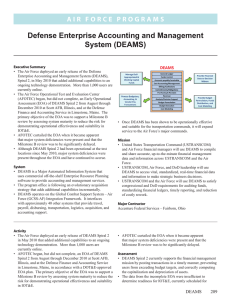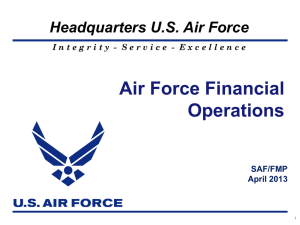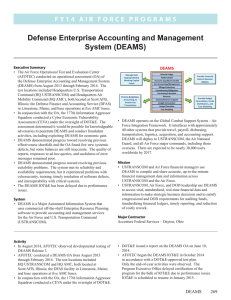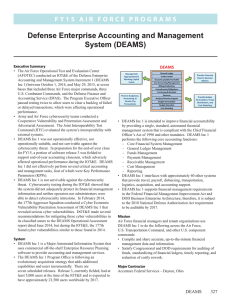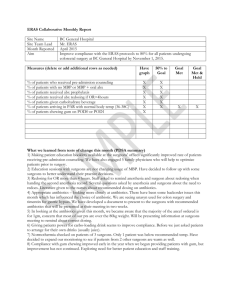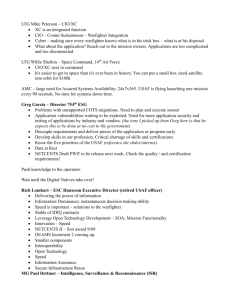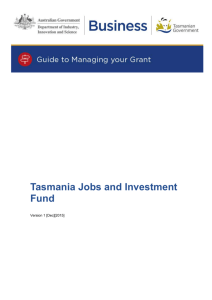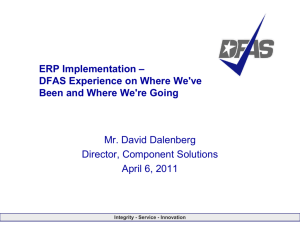A i r F o r c e ...
advertisement
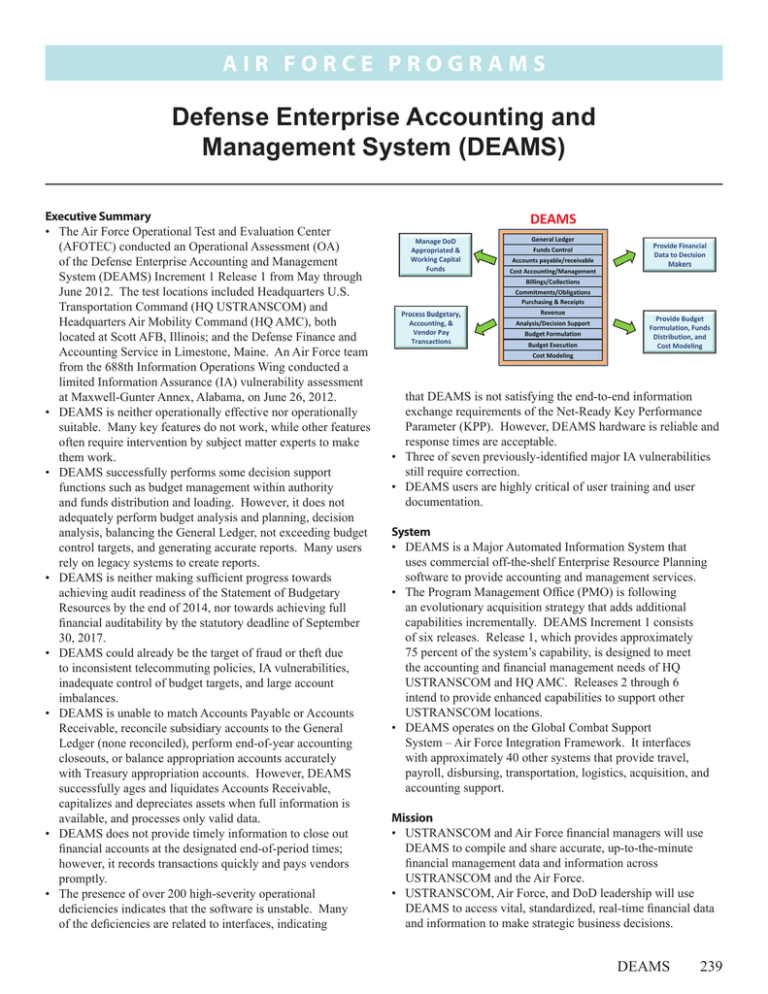
A i r F o r c e P RO G R A M S Defense Enterprise Accounting and Management System (DEAMS) Executive Summary • The Air Force Operational Test and Evaluation Center (AFOTEC) conducted an Operational Assessment (OA) of the Defense Enterprise Accounting and Management System (DEAMS) Increment 1 Release 1 from May through June 2012. The test locations included Headquarters U.S. Transportation Command (HQ USTRANSCOM) and Headquarters Air Mobility Command (HQ AMC), both located at Scott AFB, Illinois; and the Defense Finance and Accounting Service in Limestone, Maine. An Air Force team from the 688th Information Operations Wing conducted a limited Information Assurance (IA) vulnerability assessment at Maxwell-Gunter Annex, Alabama, on June 26, 2012. • DEAMS is neither operationally effective nor operationally suitable. Many key features do not work, while other features often require intervention by subject matter experts to make them work. • DEAMS successfully performs some decision support functions such as budget management within authority and funds distribution and loading. However, it does not adequately perform budget analysis and planning, decision analysis, balancing the General Ledger, not exceeding budget control targets, and generating accurate reports. Many users rely on legacy systems to create reports. • DEAMS is neither making sufficient progress towards achieving audit readiness of the Statement of Budgetary Resources by the end of 2014, nor towards achieving full financial auditability by the statutory deadline of September 30, 2017. • DEAMS could already be the target of fraud or theft due to inconsistent telecommuting policies, IA vulnerabilities, inadequate control of budget targets, and large account imbalances. • DEAMS is unable to match Accounts Payable or Accounts Receivable, reconcile subsidiary accounts to the General Ledger (none reconciled), perform end-of-year accounting closeouts, or balance appropriation accounts accurately with Treasury appropriation accounts. However, DEAMS successfully ages and liquidates Accounts Receivable, capitalizes and depreciates assets when full information is available, and processes only valid data. • DEAMS does not provide timely information to close out financial accounts at the designated end-of-period times; however, it records transactions quickly and pays vendors promptly. • The presence of over 200 high-severity operational deficiencies indicates that the software is unstable. Many of the deficiencies are related to interfaces, indicating that DEAMS is not satisfying the end-to-end information exchange requirements of the Net-Ready Key Performance Parameter (KPP). However, DEAMS hardware is reliable and response times are acceptable. • Three of seven previously-identified major IA vulnerabilities still require correction. • DEAMS users are highly critical of user training and user documentation. System • DEAMS is a Major Automated Information System that uses commercial off-the-shelf Enterprise Resource Planning software to provide accounting and management services. • The Program Management Office (PMO) is following an evolutionary acquisition strategy that adds additional capabilities incrementally. DEAMS Increment 1 consists of six releases. Release 1, which provides approximately 75 percent of the system’s capability, is designed to meet the accounting and financial management needs of HQ USTRANSCOM and HQ AMC. Releases 2 through 6 intend to provide enhanced capabilities to support other USTRANSCOM locations. • DEAMS operates on the Global Combat Support System – Air Force Integration Framework. It interfaces with approximately 40 other systems that provide travel, payroll, disbursing, transportation, logistics, acquisition, and accounting support. Mission • USTRANSCOM and Air Force financial managers will use DEAMS to compile and share accurate, up-to-the‑minute financial management data and information across USTRANSCOM and the Air Force. • USTRANSCOM, Air Force, and DoD leadership will use DEAMS to access vital, standardized, real-time financial data and information to make strategic business decisions. DEAMS 239 A i r F o r c e P RO G R A M S • USTRANSCOM and the Air Force will use DEAMS to satisfy congressional and DoD requirements for auditing funds, standardizing financial ledgers, timely reporting, and reduction of costly rework. Activity • AFOTEC began, but did not complete, an Early Operational Assessment (EOA) of DEAMS from August through December 2010 in accordance with a DOT&E-approved test plan. AFOTEC cut the EOA short when it became apparent that major system deficiencies were present and that the planned Milestone B was significantly delayed. • After the program manager declared that DEAMS had been stabilized, AFOTEC conducted a second OA of DEAMS Increment 1 Release 1 from May through June 2012 in accordance with a DOT&E-approved test plan. As with the EOA, the test locations included HQ USTRANSCOM and HQ AMC, both located at Scott AFB, Illinois; and the Defense Finance and Accounting Service in Limestone, Maine. DEAMS Increment 1 Release 1 contained approximately 75 percent of its final capabilities and had been in operational use for two years. • An Air Force team from the 688th Information Operations Wing conducted a limited IA vulnerability assessment at Maxwell-Gunter Annex, Alabama, in June 2012. • In July 2012, the DoD Inspector General reported (DoDIG-2012-111) that DEAMS’s original life‑cycle cost estimate had more than quintupled to over $2 Billion and that the program is 7.5 years behind schedule. In September 2012, another DoD Inspector General report (DoDIG-2012-140) found that DEAMS lacked critical functional capabilities needed to generate accurate and reliable financial management information and might not meet its 2014 and 2017 audit readiness requirements. • DOT&E issued an OA report on DEAMS in September 2012. A Milestone Decision Authority decision followed immediately after, allowing the Air Force to deploy DEAMS to an additional 150 AMC users at McConnell AFB, Kansas. Assessment • AFOTEC conducted the FY12 OA of DEAMS Increment 1 Release 1 with the rigor of an IOT&E. • DEAMS is neither operationally effective nor operationally suitable. Many key features do not work, while other features often require intervention by subject matter experts to make them work. • Operational testers documented deficiencies in the areas of information quality, timeliness, and usability, along with many undocumented workarounds. DEAMS hardware is reliable and response times are acceptable, but the presence of more than 200 unresolved, high-severity deficiencies indicates that the software is still unstable, despite program attempts to 240 DEAMS Major Contractor Accenture Federal Services – Fairborn, Ohio • • • • • • • resolve 245 prior high priority defects. According to the PMO, the fast tempo of delivery of software patches has not left any time for regression testing. Many of the software deficiencies are related to interfaces, indicating that DEAMS is not satisfying the end-to-end information exchange requirements of the Net Ready KPP. DEAMS is neither making sufficient progress towards achieving audit readiness of the Statement of Budgetary Resources by the end of 2014, nor towards achieving full financial auditability by the statutory deadline of September 30, 2017. DEAMS is unlikely to support financial operations because it does not meet the KPP for appropriations balance with the U.S. Treasury. Of 723 appropriation accounts examined, 109 had amounts out of balance for a total of $449 Million. DEAMS also does not meet the 95 percent KPP for General Ledger to subsidiary ledger reconciliation (none of the 49 samples reviewed were reconciled). DEAMS is unable to accurately match any Accounts Payable or Accounts Receivable documents and does not always prevent the posting of transactions that exceed Congressional appropriation funds control targets. AFOTEC identified two transactions that exceeded strict funds control by a total of $3 Million. However, DEAMS successfully ages and liquidates Accounts Receivable, capitalizes and depreciates assets when full information is available, and processes only valid data. DEAMS does not meet the KPP for timely reporting of period-end data to the official reporting system. DEAMS has not properly performed the end-of-year accounting closeouts for FY10 or FY11; however, it records transactions quickly and pays vendors promptly. DEAMS does not sustain financial decision support because it does not meet the KPP for fully accurate status of funds. While DEAMS successfully performs some decision support functions such as budget management within authority and funds distribution and loading, several important reports were inaccurate or incomplete. Many operators continue to use legacy systems, rather than DEAMS, to perform their daily tasks. DEAMS does not meet the KPP for budget control targets and is susceptible to fraud or theft. The additional in-test discovery of inconsistent telecommuting policies, IA vulnerabilities, and large account imbalances raise a concern that fraud or theft may be taking place. A i r F o r c e P RO G R A M S • Three of seven previously-noted major IA vulnerabilities still require correction. Furthermore, some DEAMS users are telecommuting without using a Virtual Private Network. • DEAMS users are highly critical of user training and user documentation. Recommendations • Status of FY11 Recommendations. The PMO and AFOTEC addressed all FY11 recommendations. • FY12 Recommendations. 1. The Air Force should conduct immediate “Financial Red Team” penetration testing to assess DEAMS’s fraud and theft vulnerabilities. The test should address both prevention and detection of potential thefts or frauds. 2. The Air Force should conduct immediate tests of the IA risks associated with telecommuting. The tests should determine whether perpetrators have attacked the system and extracted data. The PMO and the Defense Information Systems Agency should rectify all remaining IA deficiencies in order to reduce vulnerability. 3. In order to prevent the accrual of new deficiencies, the Air Force should recreate a realistic developmental test environment that incorporates automated testing and allows the conduct of thorough, systematic, repeatable regression testing. 4. The PMO and Functional Management Office should document any required workarounds authorized by the users. Similarly, the PMO should develop training to better meet individual user group requirements and improve user documentation to include workarounds and the legacy systems that are still needed for mission accomplishment. 5. AFOTEC and the Joint Interoperability Test Command should collaborate to assess interoperability that covers full Net-Ready KPP requirements, including the end-to-end functional exchange of required information. 6. The Air Force should not permit further deployments of DEAMS until substantial progress is made addressing the system’s deficiencies. DEAMS 241 A i r F o r c e P RO G R A M S 242
